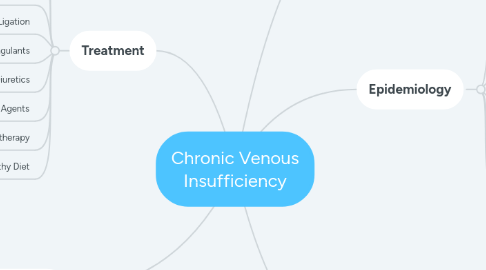Chronic Venous Insufficiency
by Drew Green

1. Treatment
1.1. Compression Stockings
1.2. Elevate Legs
1.3. Exercise
1.4. Ligation
1.5. Anticoagulants
1.6. Diuretics
1.7. Hemorrheologic Agents
1.8. Sclerotherapy
1.9. Healthy Diet
2. Symptoms
2.1. Pain aggravated by standing
2.2. Swollen feet due to edema
2.3. Leg cramps
2.4. Thickening of the skin around the ankles
3. Epidemiology
3.1. Prevalence of varicose veins increases chance. <1% to 73% in females and 2% to 56% in males
3.2. <1% to 40% in Females and <1% to 17% in males
3.3. Obesity
3.4. Pregnancy
3.5. Decreased Activity
3.6. Family History of CVD
4. Diagnosis
4.1. Duplex Ultrasound
4.2. Magnetic Resonance Venogram
4.3. CT Venogram
4.4. History and Physical
5. Pathophysiology
5.1. The calf muscle pump fails to augment venous return, and venous blood pressure is chronically elevated upon standing.
5.2. Mechanisms that normally prevent the transmission of venous hypertension back upstream to the dermal microcirculation are lost.
5.3. Early dermal microvascular responses include increased fluid filtration and edema.
5.4. An inflammatory response induces white cell activation and adhesion. It is thought that activated white cells are trapped in dermal capillaries and increase microvascular permeability.
5.5. Plasma proteins leak into the tissue space, increasing the edema. Ischemic damage to the epidermis leads to epithelial cell necrosis and ulceration.


